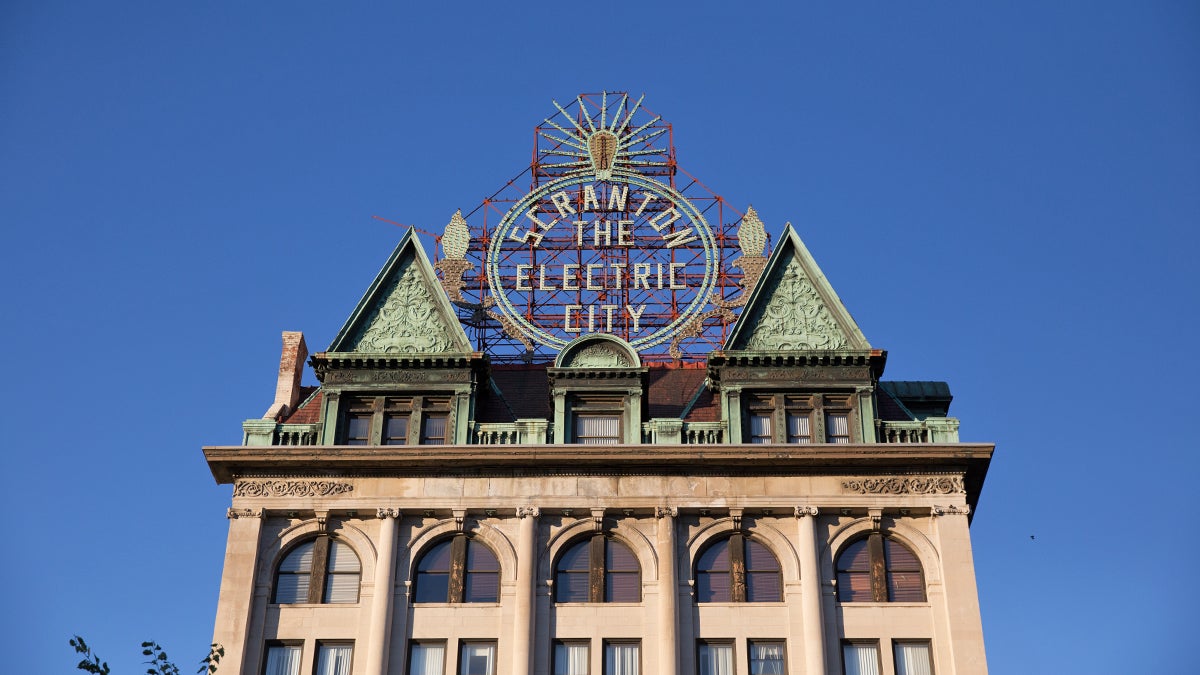Scranton, Wilkes-Barre compete to be one of ‘America’s Best Communities’

Scranton, known as the "Electric City," and Wilkes-Barre are quarter-finalists in the 'America's Best Communities' competition where winners receive funds to revitalize downtown areas. (Lindsay Lazarski/WHYY)
The two Northeastern Pa. cities are quarter-finalists in the nationwide competition. Winners will get $3 million to revitalize downtown.
To an outsider, Scranton and Wilkes-Barre seem very similar. The two cities are about half an hour apart, and they both grew up around the anthracite coal industry. Both serve as the county seat, of Lackawanna and Luzerne counties, respectively. Both have struggled to redefine themselves in the post-coal economy.
Over the years, differences have emerged. Scranton became famous for the city’s role in “The Office.” Wilkes-Barre suffered a devastating flood in 1972 that led to a lot of relief aid being poured into the city. Scranton remains nearly twice the size of Wilkes-Barre.
The neighboring cities have often found themselves cooperating and collaborating for the good of Northeastern Pa. But now, both Scranton and Wilkes-Barre have been named quarter-finalists in the national ‘America’s Best Communities’ competition — and a bit of a rivalry has emerged.
“We’re looking to be number one and two at the end of the process and whatever order that comes in, we’ll be fine with it,” says Joseph Boylan, vice president for economic development at the Wilkes-Barre Chamber of Commerce. “But we’re thinking Wilkes-Barre will be number one.”
A plan for the future
The competition is put on by Frontier Communications, DISH, CoBank and The Weather Channel, and focuses on improving cities across the country. The 50 quarter-finalists received $50,000 each to help develop a “Community Revitalization Plan.”
If Scranton or Wilkes-Barre is one of the eight finalists, the city will receive $100,000 to begin implementing their plan. From that pool of eight, three winners will be chosen to receive $3 million, $2 million or $1 million, along with an outdoor mural depicting the vibrancy of the community.
Amy Luyster, of the Scranton Chamber of Commerce, says the competition provided an incentive for the city to get everyone in a room together to have some important conversations.
“We had business leaders, residents, college students come to give us feedback,” in a series of 10 meetings, said Luyster. “We broke out into sessions and asked, what could [Scranton] be if there were no barriers?”
These meetings yielded a plan that focuses on business and workforce development in the downtown area. Scranton has invested heavily in “eds and meds,” with the University of Scranton and the Geisinger Health Center dominating the city’s landscape.
Their neighbor to the south wants to invest in making Wilkes-Barre the “Innovation District” of the region. The city has recently opened a small business and tech incubator center, and are working to attract more technology companies to the area.
It has created a plan that has both short-range and long-term goals.
“The funding would be for a bunch of different things that, collectively, can make the city better,” says Boylan. “Whether it’s investing in improvements in Public Square or introducing new historic signage downtown.”
Win, lose or draw
Both cities plan to implement a version of their community revitalization plan, whether or not they move onto the next round. Without $100,000 or the ultimate goal of $3 million, the plans might take a little longer. But at least they have plans, which is more than they could say at the beginning of the competition.
“It helps us to have one common direction that we’re moving forward in,” says Luyster. “We don’t always know what our partners are doing, and what’s being done in different parts of the city.”
These neighboring Northeastern Pa. cities will find out in January whether or not they’ve moved into the semifinals. There’s a lot of money and opportunity hanging in the balance, a real chance for two struggling coal cities to find their feet again.
But the serious matters at hand haven’t stopped the two cities from making a friendly wager.
“There may be a steak dinner riding on the outcome of this competition,” says Boylan.
Loser buys, though if one city wins $3 million, they might be expected to at least pick up the tip.
Editor’s note: A previous version of this article misstated the year Wilkes-Barre flooded. The flood from Hurricane Agnes occurred in 1972.
Update 1/29/16: Neither Scranton nor Wilkes-Barre advanced to the semi-final round of the competition. Speaking to the Scranton city council Thursday, Chamber of Commerce president Robert Durkin said the experience was still worthwhile. Both cities received $50,000 in funding to create a community revitalization plan, something Durkin referred to as “an eye-opener for all of us.”
WHYY is your source for fact-based, in-depth journalism and information. As a nonprofit organization, we rely on financial support from readers like you. Please give today.


